
DevOps automating solutions: In streamlining is a victory
Nowadays, the demands placed on developer teams have surged, necessitating efficient and rapid launches. Imagine if there were specialized automation services and solutions readily available to alleviate the workload for both developers and companies. Well, we’re here to tell you that this isn’t just a concept but a tangible reality.
There are virtually no challenges that can’t be addressed through the expertise of automation specialists. Business owners continually seek opportunities to advance and optimize various workflows, and this is precisely where DevOps practices come into play. Even in situations where developers face collaboration difficulties, salvation arrives in the form of advanced automation tools and implementation.
Only through a collaborative approach alongside cutting-edge technologies can developers reach a consensus on creating their magnum opus. Simultaneously, the integration of best practices in automation serves as a guiding force, streamlining a multitude of development processes, including continuous integration, delivery, infrastructure-as-code, configuration management, and monitoring and analytics. This results in scalable and efficient deployments.
But the pivotal question remains – can these automation experts truly revolutionize existing approaches to developing applications with their undoubtedly powerful arsenal of tools and support services?
Let’s uncover the answer in this article as we delve into the transformative potential of automation solutions, unveiling the possibilities for fostering a collaborative approach within development teams and redefining the future of development.
The evolution of DevOps: Awaiting the hero
As we delve into all that DevOps has to offer, let’s explore the very roots of the software development life cycle (SDLC). In a nutshell, SDLC is a method for designing, developing, testing, and delivering software. It consists of a series of phases, each of which depends on the results of the previous one.
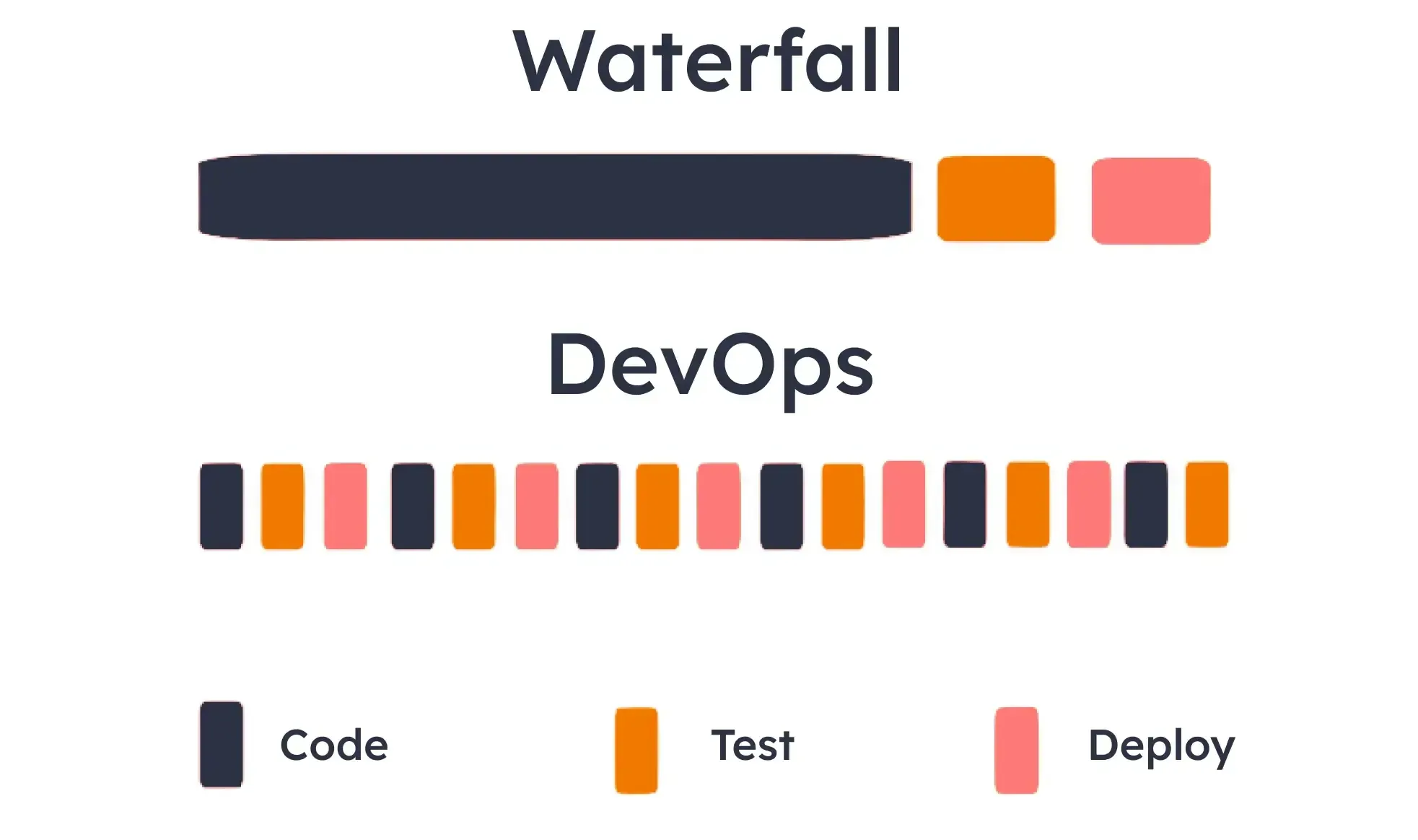
Before the advent of DevOps automation solutions, there was a traditional model of SDLC called Waterfall. This model outlines a linear and sequential approach to software development for specific use cases. One of its key features is that each phase must be completed before the next one can begin, and the phases must not overlap.
Now, let’s delve deeper into these phases:
Requirements analysis:
During this phase, the project’s requirements are meticulously examined and documented in precise Requirements Understanding Documents (RUD).Design:
Following requirements analysis, we move into the solution modeling phase. Here, we consider all system requirements, including software infrastructure, user interface, programming languages, and data layers to achieve a harmonious synergy.Implementation:
This marks the construction phase. With all requirements in hand, we start writing code in the form of small, manageable units, which are then seamlessly integrated into the software.Integration and testing:
After creating these units, they’re entrusted to the testing team. The phase concentrates on identifying and eliminating bugs and rectifying any potential flaws. Client involvement remains essential throughout this critical stage.Deployment:
This stage involves the release of the final software version onto the client's production server for actual use. Users play an active role here, providing feedback and promptly reporting any issues encountered.Maintenance:
Even after releasing the software into the open world, responsible developers must continue to care for their creation. This entails supporting application performance by addressing bugs and ensuring it remains up-to-date – an essential aspect of ensuring long-term success.
It sounds quite appealing, doesn’t it? But despite being a robust system at first glance, there is one significant flaw – all these phases are performed manually by the developers, which sometimes can be quite a pain. The lack of flexibility and adaptability for unforeseen events also limits the potential for developers to fully unlock the power of the software.
As the DevOps services emerged, the capability to automate each step of development was truly a breath of fresh air. An all-encompassing arsenal of tools for versatile development processes provides developers with a high level of adaptability. DevOps automation solutions stood up as a hero for the entire IT industry, streamlining development processes and overcoming all possible bottlenecks.
DevOps automation best practices
The core objective of implementing DevOps automation is to enable individuals to make informed and intelligent decisions in the development process. To succeed, there are core principles for developers to follow to drive the team’s accomplishments. Why don’t we have a gander at them while forming a basic understanding of DevOps automation best practices:
Fostering collaboration and communication:
A sincere passion for the development process is the key factor for developers to reach the apex. And what could be better than this? The devotion to creating revolutionizing solutions is shared between development and operation teams.Automation in all things:
The strictest and most significant principle of DevOps development lies in automation. Streamlining each step of building the software and increasing development and deployment speed is fundamental for the DevOps approach.Sharing responsibility:
As collaboration is encouraged with DevOps implementation, the responsibility for the project’s well-being is embedded in each member of both operation and development teams, regardless of their contribution.Constant integration and delivery:
Consistent integration is the way to improve overall performance and foster even stronger bonds between team members.Now that we have covered the principles of DevOps to adhere to, we can proceed to the automation tools themselves – the main pillars supporting the entire approach. Effectively leveraging the features offered by DevOps automation providers can significantly ease the core development phases:
Documentation precision:
Automation tools act as vigilant sentinels, ensuring that each release emerges as the latest, meticulously error-free version.Development efficiency:
Thanks to tracking systems offered by DevOps automation tools providers, developers navigate the development process seamlessly, keeping a watchful eye on code evolution.Integration excellence:
Automation tools assume a pivotal role, championing accuracy by promptly identifying issues and errors in the initial stages of development.Testing proficiency:
Enter the domain of specialized tools that orchestrate the automation of testing, guaranteeing a code that is free from flaws and poised for deployment.Deployment agility:
Through automated deployment processes, solutions launch quickly and precisely, delivering an efficient and effective debut.Maintenance insight:
Automated monitoring tools take on the role of vigilant observers, providing real-time insights into ongoing application performance and promptly flagging emerging issues.
A prominent role in DevOps automation services is held by the practice of infrastructure-as-code (IaC). In essence, IaC allows teams to manage infrastructure in a repeatable, scalable, and automated manner. The core feature of this practice is representing the entire system in the form of code, which can be easily modified and fixed when needed. What more can developers ask for? Let’s find out now.
Benefits of DevOps: Real-World Examples
As we advance further, we should know what to look for while implementing DevOps automation software. The core feature of these solutions is carrying out all development phases with a minimum of human intervention to improve accuracy and overall efficiency. They serve a good purpose for both developers and companies, that are awaiting the launch of promising solutions. Get a closer look at the brief overview of the essential benefits of DevOps automation implementation for development processes:
Speed and efficiency
DevOps automation has redefined the speed of development and deployment, enabling rapid feature delivery and efficient bug fixes. A prime illustration of this is Netflix, a media giant that once grappled with the challenge of handling massive traffic using an inadequate monolithic architecture.
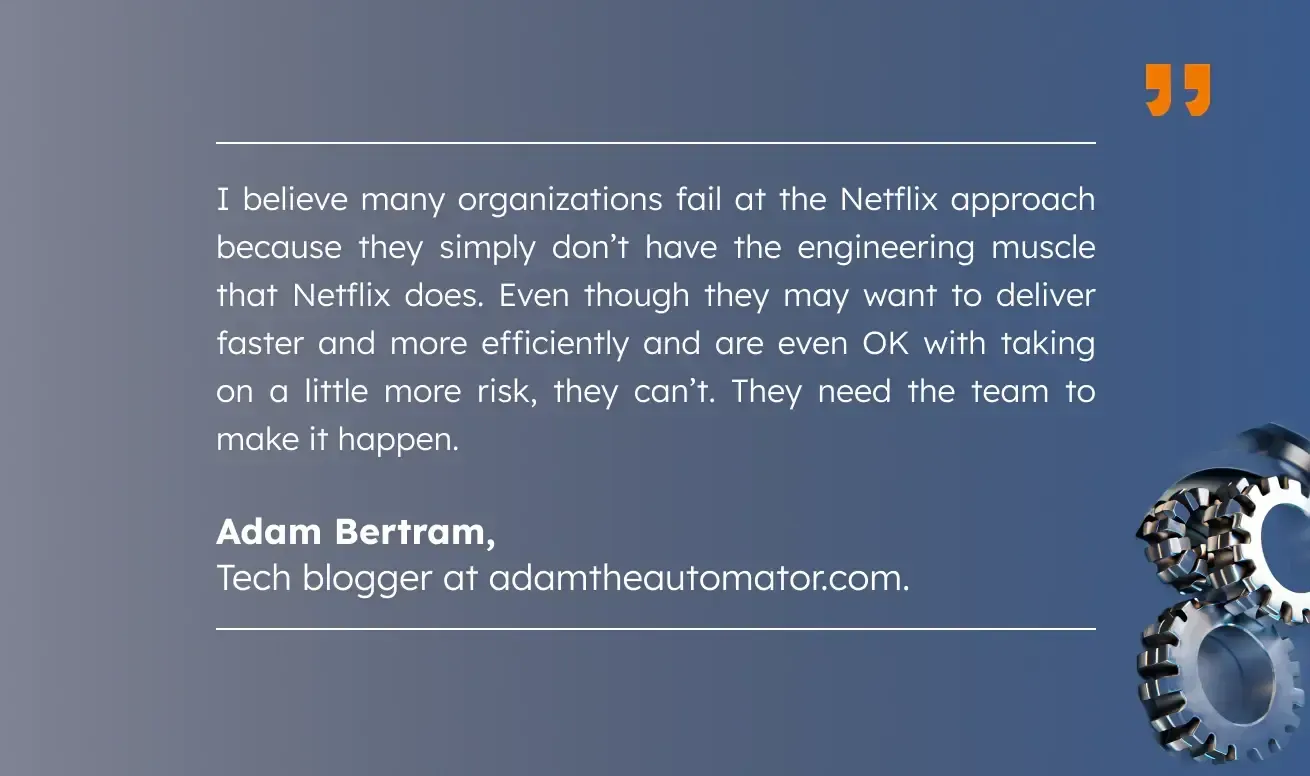
Netflix’s transformation journey involved embracing DevOps automation tools and transitioning to a well-maintained microservices architecture. This strategic move empowered the platform’s performance and seamlessly enhanced its capacity to handle heavy traffic.
Reduced costs
One of the most tangible benefits of automation is cost reduction. By eliminating the need for manual intervention in routine tasks, DevOps automation contributes to substantial savings. Etsy, a trailblazer in leveraging DevOps automation solutions, offers a compelling case study. Etsy’s quest for efficiency led to an innovative approach, allowing it to compete effectively with other e-commerce giants. DevOps automation played a pivotal role in achieving a cost-effective equilibrium.
Reliability
Automated systems are inherently less susceptible to human error, resulting in dependable code deployment and management. While trust in algorithms continues to evolve, there's ample room for improvement. Coming back to Etsy, their journey towards success involved a strategic shift to micro infrastructure, instilling confidence in automated code management. This decision made maintaining services considerably more manageable and reliable.

Increased productivity
DevOps automation liberates development teams from routine tasks, enabling them to focus on mission-critical activities. Additionally, DevOps automation solutions offer various features for enhancements, including live monitoring and data analysis. Amazon’s experience serves as a compelling example. Faced with surging traffic and the imperative to adapt swiftly to volatile market conditions post haste, the company turned to DevOps automation services. The result was a remarkable surge in development and deployment rates, firmly establishing Amazon as an e-commerce industry leader.
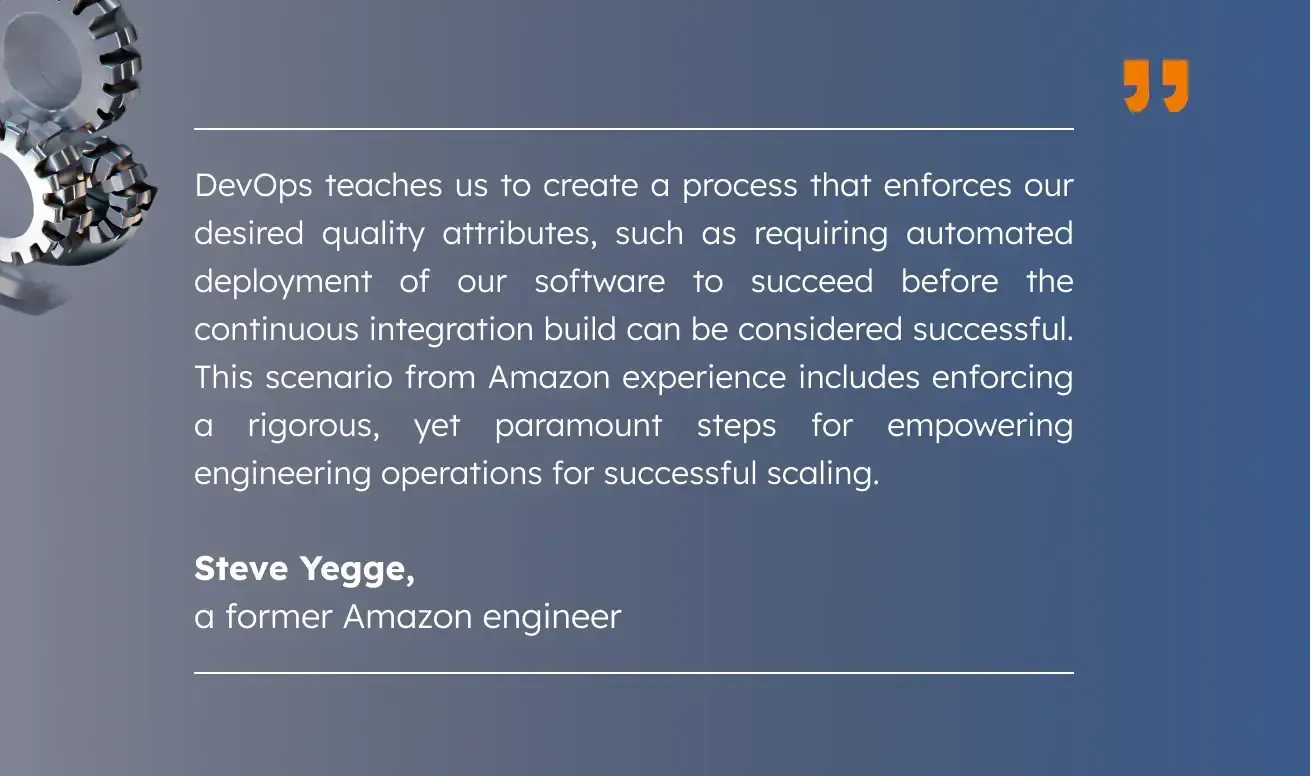
The transformative potential of DevOps automation is vividly demonstrated through these real-world stories. It not only streamlines development operations but also fosters opportunities for businesses and enterprises to thrive. Engaging DevOps automation experts can significantly alleviate the workload of development and operations teams, making the realization of any idea more attainable.
Integration in DevOps: Cohesion is the way
When it comes to successful code integration and subsequent deployment, several practices enter the arena, which are continuous integration (CI) and continuous delivery//continuous deployment (CD). Let’s define what they are and their possible uses for reducing software development time within SDLC.
CI can be described as a set of methods ensuring the proper work of software components. The integration should be completed frequently; if possible, on an hourly or daily basis.
A typical first step in this DevOps pipeline is to build the latest version of the source code. In case of build is successful, unit tests are executed. If they succeed, the build is deployed to test environments where system tests are performed. And the verification process itself is carried out with the help of DevOps automation specialists, which create specific algorithms for conducting accurate and flexible performance tests followed by debugging.
As we move to CD, there are several differences worth pointing out. Naturally, it picks up the next phase of development, where the work of CI is over. The CD helps newly emerged software to get a quicker trip from the testing environment into the hands of a client. The essential part of DevOps automation practices here lies in providing constant live maintenance of the newly made solutions, as well as carrying out the swift and effective deployment.
| Aspect | Continuous Integration (CI) | Continuous Deployment (CD) |
| Definition | Automatically integrating code changes from multiple contributors into a shared repository, often multiple times a day. | Automatically deploying code changes to production or staging environments after passing CI tests. |
| Objective | Frequent integration of code changes to detect integration issues early. | Accelerated delivery of new features and bug fixes to end-users. |
| Key components | Version control, Automated Build, Automated Testing. | CI Pipeline, Deployment Automation, Monitoring. |
| Order in DevOps pipeline | First step in the DevOps pipeline. | Follows CI and automates deployment. |
| Benefits | Reduced integration issues, faster code feedback, improved code quality. | Rapid delivery of new features, reduced manual intervention, increased release frequency. |
| Challenges | Ensuring consistent test environments, managing test suites, addressing integration conflicts. | Managing deployment pipelines, monitoring production systems, handling rollback procedures. |
All these practices are the perfect examples of sufficient integration of distinct systems alongside successful deployment in a testing environment. We can already notice their significant contribution at the stages of testing the codes and fixing the flaws. They not only improve the overall quality of the code but also bring together two different development teams, both of which hold critical value for the entire project. Despite the existence of skeptical views regarding the automation of essential SDLC steps, we firmly believe that this sacred process should be by the devs, for the devs, and done by the devs.
Securing the DevOps pipeline: Ensuring a smooth run
With the automation of the development cycle, there are hardly any processes that need to be manually maintained. While this is undoubtedly a relief from hard work, the main concern that occupies every company is security. Ensuring a smooth run of the SDLC remains as significant as ever because it’s always better to identify possible weaknesses in the software and address them immediately, rather than dealing with the consequences of those mistakes later. Now DevOps turns into DevSecOps automation solutions, which is a vigilant warden keeping an eye on the most vulnerable parts of solutions. Have a look at the most effective practices utilized to enhance security throughout the entire development life cycle:
Vulnerability management:
Initiating several processes to manage and track vulnerabilities is a good starting point. Regularly scanning applications and infrastructure for known vulnerabilities and promptly applying security patches can significantly enhance the security of the SDLC pipeline. When it comes to DevOps automation tools, implementing continuous monitoring of potential flaws can improve overall awareness.Security as code:
Adopting this approach involves treating infrastructure security and specific policies as integral parts of the code. With version control features and automated testing and deployment systems, DevSecOps automation specialists ensure the scalability of the product and enhance the software’s ability to adapt across different environments.Automated compliance:
By implementing automated compliance checks and audits, DevOps automation specialists ensure adherence to security standards and regulations. Regularly assessing and validating security controls are key methods for maintaining a secure posture.
The scalability of your software solution is not just a future consideration but a strategic necessity. By addressing infrastructure scaling, configuration management, team collaboration, monitoring, and CI/CD pipelines, you can position your product for success in the ever-expanding digital landscape.
DevOps scalability and flexibility for complex environments
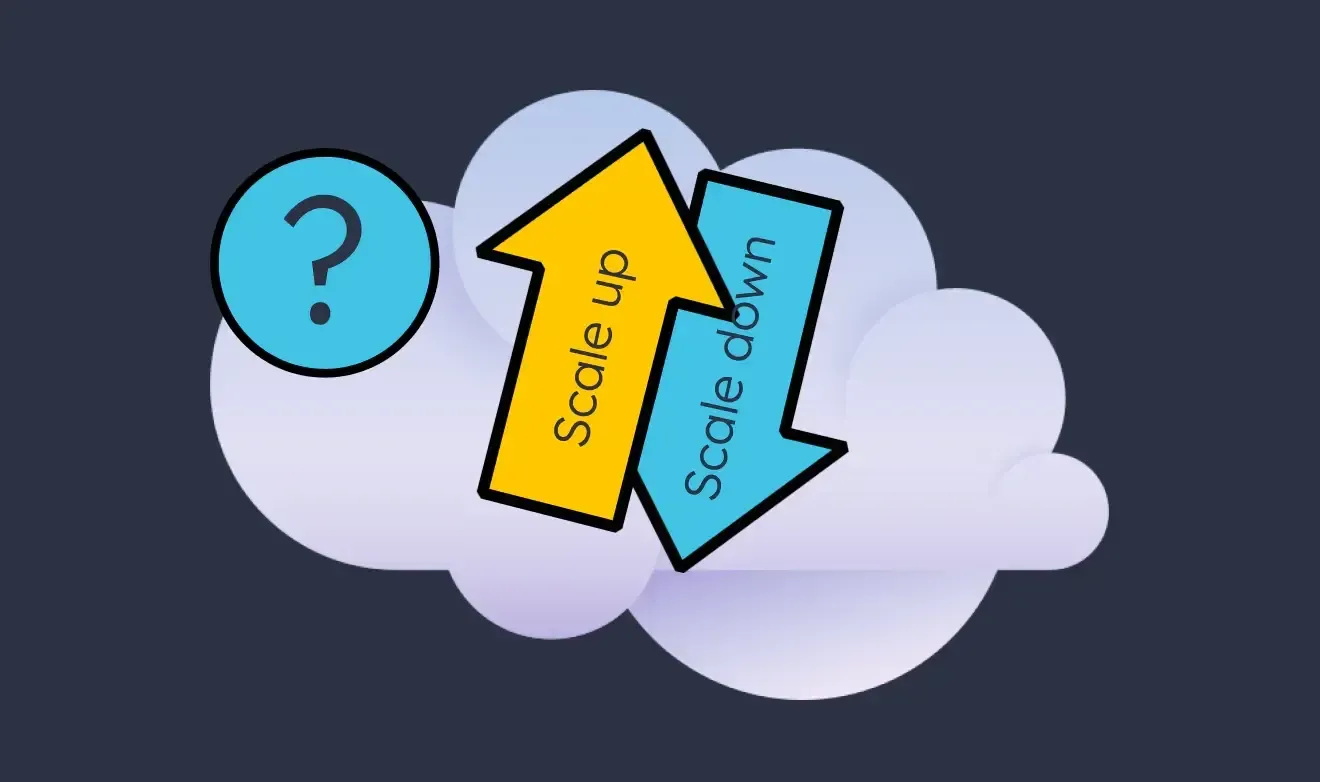
Eventually, the moment when the solution overgrows the current environment will come. Consequently, a new issue will emerge concerning the future of software and its potential for scaling into larger systems. To ensure successful scaling of every aspect of the software, one must find and employ specific approaches to enhancing the product’s scalability:
Infrastructure scaling:
Ensuring that infrastructure resources (servers, containers, virtual machines, etc.) can be quickly provisioned and de-provisioned as needed. Following that way, the coordination and scaling of resources can reach new heights.Configuration management:
Using DevOps configuration management tools that can handle the growth in infrastructure and application components. Having high adaptability also results in a more stable presence of defined configurations.Team collaboration:
Maintaining effective communication and collaboration among development and operations teams as the organization continues to progress. Additionally, all infrastructure and processes-related knowledge should be shared between both teams to facilitate better cooperation.Monitoring:
Handling the increasing volume of data generated by monitoring and logging systems can strain storage and analysis resources. It’s worth mentioning the possible enhancement of real-time tracking systems to improve response capabilities.CI/CD pipelines:
Ensuring that development and deployment pipelines can accommodate numerous applications and services without performance degradation is crucial for further advancement.
As software solutions evolve and expand, the challenges of scalability become increasingly significant. Embracing DevOps strategies will help organizations navigate the complexities of growth and pave the way for a successful and scalable future.
As we already know, DevOps automation services stand as great tools for streamlining development life cycles and enhancing team collaboration. However, it is crucial to address the impending challenges of DevOps adoption. Let’s identify the primary issues standing in the way of implementing DevOps automation tools and find the solutions for them:
CI/CD performance issues: Suboptimal implementation of the CI/CD pipeline can lead to recurring problems such as slow page loads for websites, delayed responses from servers, and poor memory optimization that hampers the overall performance of the application.
The solution lies in automating testing processes and providing robust monitoring solutions to effectively respond to unexpected changes.
Security concerns: As mentioned before, ensuring a smooth run for the development life cycle is crucial because, in the event of a breach, the consequences can be critical.
Detecting possible flaws in the early stages with DevOps automation monitoring and analytics is the correct approach. Additionally, reducing the presence of sensitive data in code mitigates the risks of potential theft and fraud.
Interpreting debugging reports: Complex test reports can be difficult for all stakeholders to grasp, resulting in delays in bug fixes and impacting product release velocity.
Consider implementing real-time reporting for more comprehensive analysis. Visualizing report data using various software tools can be a valuable addition to increasing deployment rates.
By proactively addressing these challenges and implementing the recommended solutions, organizations can fully harness the potential of DevOps automation services. This proactive approach not only enhances development processes but also strengthens security and accelerates the delivery of high-quality software products.
A peek into the future: DevOps automation trends
The vital role of DevOps automation is undeniable, as it offers tremendous potential for streamlining the SDLC for developers. Despite the future being clouded with unpredictable outcomes and innovation to harness, we can envision the trajectory of DevOps automation solutions through future trends:
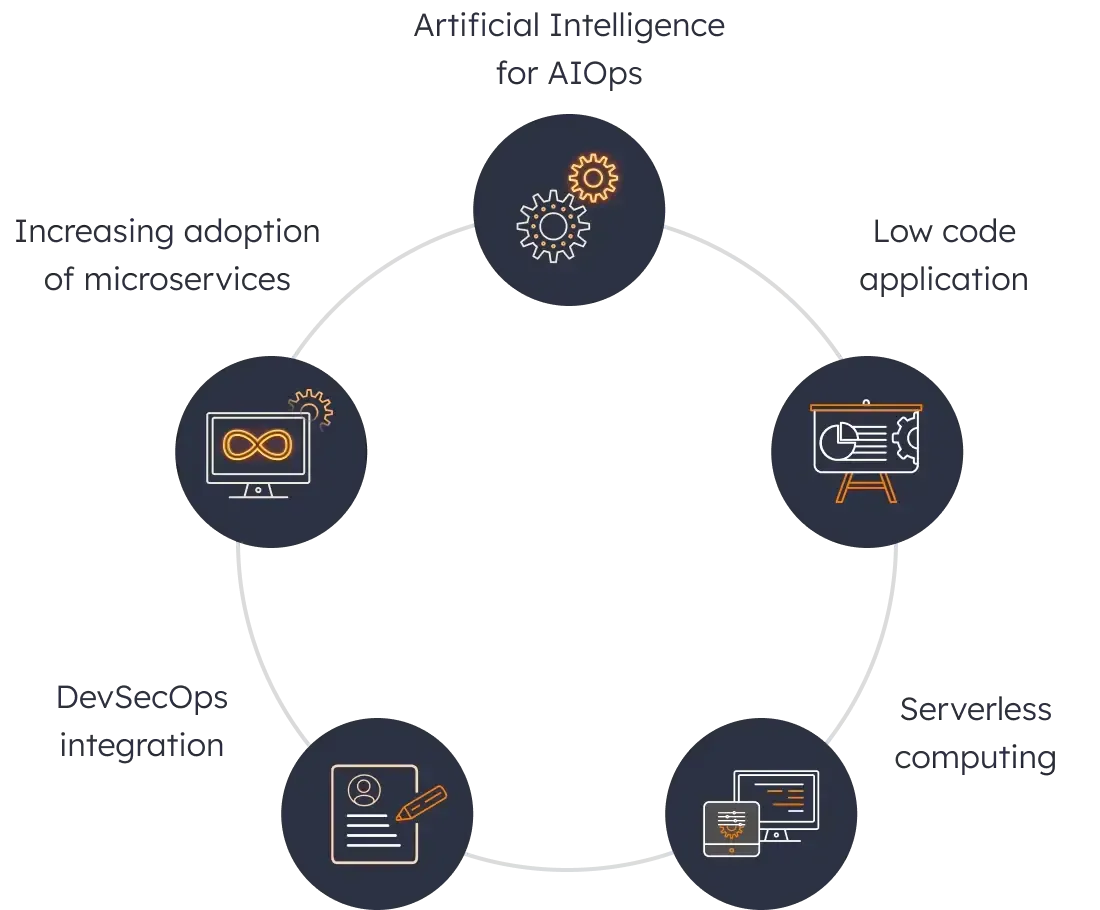
Artificial Intelligence for IT operations (AIOps): This might be expected, anything related to automation can be associated with artificial intelligence or machine learning techniques in some way. DevOps is no exception. Its potential for automating IT processes and providing AI-driven testing in DevOps will only grow as AI and ML technologies continue to evolve.
Increasing adoption of microservices:Many software enterprises are implementing microservices infrastructure to develop business solutions independently across several services. Containerization is also gaining popularity because it is designed to run processes one at a time with minimal deployment overhead, making it an ideal deployment model.
DevSecOps integration: The importance of security in the DevOps pipeline will continue to grow. DevSecOps, the integration of security practices into DevOps processes, will become standard to ensure secure development and deployment.
Serverless computing: The serverless computing model, where cloud providers manage the infrastructure, will become a go-to choice for deploying applications. It offers cost-efficiency and scalability, aligning with DevOps principles.
Low code application: If there are more ways to simplify the development process, they are likely to capture the attention of companies. In the case of low-code practices, it allows people with limited technical knowledge to have an impact on development processes without the need for extensive coding knowledge. From this, we can conclude that a synergy of DevOps automation services and low-code practices will be a valuable addition to one another.
The journey of DevOps automation is an ongoing one, with exciting trends adoption paving the way for the future. Embracing these advancements will further empower developers and organizations to streamline their processes and achieve even greater efficiency.
Wrapping up
The progress has shown us that there are no boundaries for advancing and simplifying processes in every specific industry.
In the case of software development, there are numerous practices to consider, but DevOps with its outstanding automation tools holds a special place on the pedestal. It fosters greater communication between the operation and development teams, promoting a collaborative approach that increases overall efficiency.
Empower your development journey with DevOps expertise.
Modsen’s automation specialists are ready to assist you.
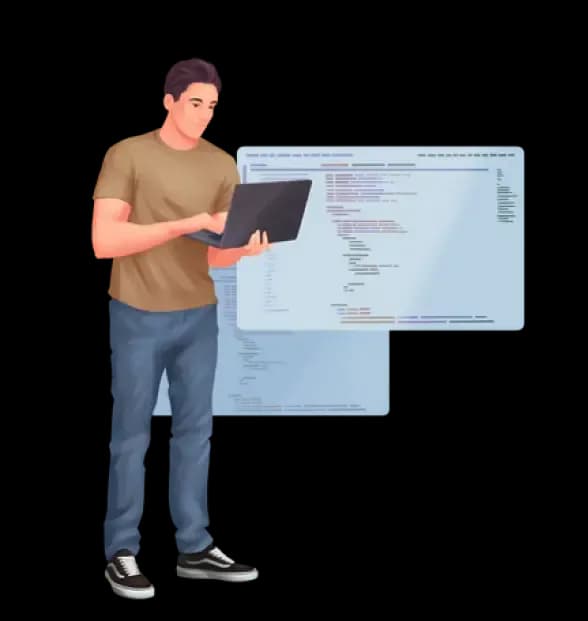
The automation potential of DevOps guides developers through the entire SDLC offering comprehensive support at each significant phase of development. Gathering and proofing needed requirements, providing exceptional designs for application, conducting error-free testing, and carrying out constant live support and maintenance of fresh solutions – the embodiment of progress’ generosity and sustainability.
Collaboration is the key in the modern world to staying ahead of the curve and defeating competitors with cutting-edge technologies. Consider exploring our DevOps services to gain the upper hand on the market and discover all the innovations have to offer. Let’s ride the waves of progress together and stay tuned!,